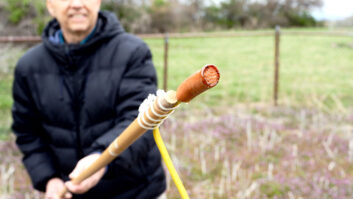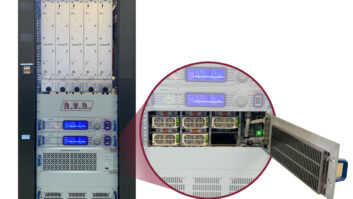Frequent contributor Charles “Buc” Fitch, P.E., had a client who lost a 24VDC logic supply at the transmitter site. The power supply loss prevented logic for the backup system to operate. The customer had installed dual 24 VDC power supplies but needed some way of linking the two supplies in a main/standby mode.

Buc came up with the controller schematic shown in Fig. 1. Parts are not critical. The panel has an audible alarm, which can be a Sonalert or a less expensive audible alarm. The only requirement is that the alarm use 24 VDC.
The Electronic Goldmine or Marlin websites have alternative buzzers, though not always in stock. Consistent supply of material is certainly an issue these days for the do-it-yourselfer.
Marlin uses MPJA as an acronym. Their site is www.mpja.com.
The two relays are standard 24 VDC DPDT relays. If all you have are 12 VDC relays, you can certainly use a 12V zener diode ahead of the relay coils to drop the voltage.
The completed project will control two 24 VDC supplies operating in parallel, which provides constant backup. If either supply fails, the audible alarm provides flexible alerting to staff.
* * *
WTRH(TV)’s Roberta Barmore has been following our discussions about replacement insulators. She’s surprised that no one has mentioned an “old standby” replacement for HV/RF insulators: glass soft-drink bottles.
These days, soda pop is more likely to be sold in cans. But there was a time when every radio station worthy of the name had convinced at least one local bottler to install a cola machine at the station. The accompanying rack of empties was an attractive source of five-cent insulators.
You wash and dry the bottle, then epoxy a bolt in the narrow end, along with some kind of mounting flange or clamp to the wide end. Even without that refinement, they’d work.
Remember the tip of isolating a shorted AM modulation transformer from the ground, using some sort of insulator? Many a local AM station stayed on the air with a shorted-to-frame modulation reactor or transformer sitting on four empty “shorty” glass soda bottles while waiting for replacement parts to arrive.
Thanks for the memory, Roberta.
Whether you’re using PVC or glass bottles as a temporary insulator, always consider the voltages.
And with that in mind, consider this comment from engineer Henry Downs.
Henry worked with me at Dielectric. After reading our PVC pipe insulator tip, Henry thought readers would be interested in the following: Henry used numerous plastics, such as PEEK and ULTEM, two “low RF loss” materials, in his filter and antenna designs while at Dielectric.

He discovered that the plastics were relatively low loss at room temperature, with loss tangents on the order of 0.0014 to 0.002. However, as the temperature rose, the loss tangents rose dramatically, such that a temperature increase from 23degrees Celcius to 120 C yielded a loss tangent increase of approximately 10 times.
As a result, the application of RF power can, under the right circumstances, cause thermal runaway of the insulating part.
If you feel you have to use a polymer material, Henry recommends Teflon, where this runaway does not seem to occur.
* * *
We wrote recently about towers “in the crosshairs.”
Years ago, engineer Jim Appleton and his team were installing two new towers for an AM station to go DA. They had installed 60 feet of the first tower and were up on the structure when they heard a bang and a twang below them.
Jim and his crew started screaming, looked around and saw a hunter running up over the hill. Gone!
The guy had shot the tower about 20 feet below them — a little too close for comfort!
To make matters worse, during that same project someone stole nine 200-pound rolls of copper ground radial wire!
* * *
We’ve discussed the differences between 50- and 75-ohm Type N connectors, and the fact that 75-ohm is costly and hard to find.
Greg Muir of WolfRam Engineering was building a translator for a client. He thought the antennas terminated in 50 ohms, but once on site, he found the antennas needed 75-ohm connectors, and all he had were 50-ohm Type N connectors. So Greg got to work.
At the risk of violating the connector’s electrical characteristics a bit, Greg — who has machining ability — chucked the 50-ohm center pin in a lathe and took 30-thousandths of an inch off the pin. The result was a 75-ohm connector to mate with the antennas.
The mod worked, even though Greg hasn’t yet put one of these modified connectors on his network analyzer.
As with the PVC insulator, when you are in a corner with no connectors and under pressure to get something done, quick fixes can save you. This one seems to work well.
Greg adds that he’s out of the captive broadcast employment trenches; he says he prefers to work at his own engineering company where he can help clients in a quality manner.
Thanks, Greg, for a unique temporary solution.
Contribute to Workbench. You’ll help your fellow engineers and qualify for SBE recertification credit. Send Workbench tips to [email protected]. Fax to (603) 472-4944.
Author John Bisset has spent 44 years in the broadcasting industry and is still learning. He is SBE Certified and is a past recipient of the SBE’s Educator of the Year Award.












